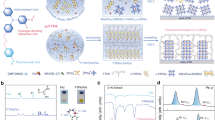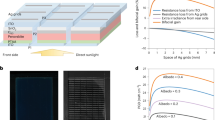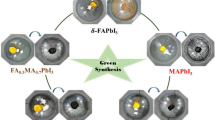Abstract
In the fabrication of FAPbI3-based perovskite solar cells, Lewis bases play a crucial role in facilitating the formation of the desired photovoltaic α-phase. However, an inherent contradiction exists in their role: they must strongly bind to stabilize the intermediate δ-phase, yet weakly bind for rapid removal to enable phase transition and grain growth. To resolve this conflict, we introduced an on-demand Lewis base molecule formation strategy. This approach utilized Lewis-acid-containing organic salts as synthesis additives, which deprotonated to generate Lewis bases precisely when needed and could be reprotonated back to salts for rapid removal once their role is fulfilled. This method promoted the optimal crystallization of α-phase FAPbI3 perovskite films, ensuring the uniform vertical distribution of A-site cations, larger grain sizes and fewer voids at buried interfaces. Perovskite solar cells incorporating semicarbazide hydrochloride achieved an efficiency of 26.1%, with a National Renewable Energy Laboratory-certified quasi-steady-state efficiency of 25.33%. These cells retained 96% of their initial efficiency after 1,000 h of operation at 85 °C under maximum power point tracking. Additionally, mini-modules with an aperture area of 11.52 cm2 reached an efficiency of 21.47%. This strategy is broadly applicable to all Lewis-acid-containing organic salts with low acid dissociation constants and offers a universal approach to enhance the performance of perovskite solar cells and modules.
This is a preview of subscription content, access via your institution
Access options
Access Nature and 54 other Nature Portfolio journals
Get Nature+, our best-value online-access subscription
27,99 € / 30 days
cancel any time
Subscribe to this journal
Receive 12 print issues and online access
269,00 € per year
only 22,42 € per issue
Buy this article
- Purchase on SpringerLink
- Instant access to full article PDF
Prices may be subject to local taxes which are calculated during checkout




Similar content being viewed by others
Data availability
The main data supporting the findings of this study are available in the Article and its Supplementary Information. Additional data are available from the corresponding authors on reasonable request.
References
Park, J. et al. Controlled growth of perovskite layers with volatile alkylammonium chlorides. Nature 616, 724–730 (2023).
Hui, W. et al. Stabilizing black-phase formamidinium perovskite formation at room temperature and high humidity. Science 371, 1359–1364 (2021).
Chen, H. et al. Improved charge extraction in inverted perovskite solar cells with dual-site-binding ligands. Science 384, 189–193 (2024).
Li, X. et al. Constructing heterojunctions by surface sulfidation for efficient inverted perovskite solar cells. Science 375, 434–437 (2022).
Jiang, Q. et al. Surface reaction for efficient and stable inverted perovskite solar cells. Nature 611, 278–283 (2022).
Chen, R. et al. Reduction of bulk and surface defects in inverted methylammonium- and bromide-free formamidinium perovskite solar cells. Nat. Energy 8, 839–849 (2023).
Hou, T. et al. Methylammonium‐free ink for low‐temperature crystallization of α‐FAPbI3 perovskite. Adv. Energy Mater. 14, 2400932 (2024).
Jeong, J. et al. Pseudo-halide anion engineering for α-FAPbI3 perovskite solar cells. Nature 592, 381–385 (2021).
Kim, M. et al. Methylammonium chloride induces intermediate phase stabilization for efficient perovskite solar cells. Joule 3, 2179–2192 (2019).
Niu, T. et al. Phase-pure α-FAPbI3 perovskite solar cells via activating lead-iodine frameworks. Adv. Mater. 36, e2309171 (2023).
Chao, L. et al. Direct and stable α-phase formation via ionic liquid solvation for formamidinium-based perovskite solar cells. Joule 6, 2203–2217 (2022).
Liu, C., Cheng, Y. B. & Ge, Z. Understanding of perovskite crystal growth and film formation in scalable deposition processes. Chem. Soc. Rev. 49, 1653–1687 (2020).
Castro-Mendez, A. F. et al. Tailoring interface energies via phosphonic acids to grow and stabilize cubic FAPbI3 deposited by thermal evaporation. J. Am. Chem. Soc. 14, 18459–18469 (2024).
Sidhik, S. et al. Two-dimensional perovskite templates for durable, efficient formamidinium perovskite solar cells. Science 384, 1227–1235 (2024).
Bai, Y. et al. Initializing film homogeneity to retard phase segregation for stable perovskite solar cells. Science 378, 747–754 (2022).
Liang, Z. et al. Homogenizing out-of-plane cation composition in perovskite solar cells. Nature 624, 557–563 (2023).
Chen, H. et al. Quantum-size-tuned heterostructures enable efficient and stable inverted perovskite solar cells. Nat. Photon. 16, 352–358 (2022).
Jiang, Q. et al. Surface passivation of perovskite film for efficient solar cells. Nat. Photon. 13, 460–466 (2019).
Chen, S. et al. Stabilizing perovskite-substrate interfaces for high-performance perovskite modules. Science 373, 902–907 (2021).
Bu, T. et al. Lead halide–templated crystallization of methylamine-free perovskite for efficient photovoltaic modules. Science 372, 1327–1332 (2021).
Lu, H. et al. Vapor-assisted deposition of highly efficient, stable black-phase FAPbI3 perovskite solar cells. Science 370, eabb8985 (2020).
Xu, Z. et al. Reducing energy barrier of δ-to-α phase transition for printed formamidinium lead iodide photovoltaic devices. Nano Energy 91, 106658 (2022).
Huang, X. et al. Solvent gaming chemistry to control the quality of halide perovskite thin films for photovoltaics. ACS Cent. Sci. 8, 1008–1016 (2022).
Huang, Z. et al. Anion-π interactions suppress phase impurities in FAPbI3 solar cells. Nature 623, 531–537 (2023).
Sun, N. et al. Tailoring crystallization dynamics of CsPbI3 for scalable production of efficient inorganic perovskite solar cells. Adv. Funct. Mater. 34, 2309894 (2023).
Xu, J. et al. Anion optimization for bifunctional surface passivation in perovskite solar cells. Nat. Mater. 22, 1507–1514 (2023).
Li, C. et al. Rational design of Lewis base molecules for stable and efficient inverted perovskite solar cells. Science 379, 690–694 (2023).
Fu, S. et al. Efficient passivation with lead pyridine‐2‐carboxylic for high‐performance and stable perovskite solar cells. Adv. Energy Mater. 9, 1901852 (2019).
Azmi, R. et al. Double-side 2-dimensional/3-dimensional heterojunctions for inverted perovskite solar cells. Nature 628, 93–98 (2024).
Peng, W. et al. Reducing nonradiative recombination in perovskite solar cells with a porous insulator contact. Science 379, 683–690 (2023).
Zhang, S. et al. Minimizing buried interfacial defects for efficient inverted perovskite solar cells. Science 380, 404–409 (2023).
Wang, M. et al. Ammonium cations with high pKa in perovskite solar cells for improved high-temperature photostability. Nat. Energy 8, 1229–1239 (2023).
Du, X. et al. Synergistic crystallization and passivation by a single molecular additive for high-performance perovskite solar cells. Adv. Mater. 34, e2204098 (2022).
Zheng, Y. et al. Dual‐interface modification for inverted methylammonium‐free perovskite solar cells of 25.35% efficiency with balanced crystallization. Adv. Energy Mater. 14, 2304486 (2024).
Chen, T. et al. Entropy-driven structural transition and kinetic trapping in formamidinium lead iodide perovskite. Sci. Adv. 2, e1601650 (2016).
Kim, H. S. et al. Vacuum-assisted reforming cathode interlayer orientation for efficient and stable perovskite solar cells. Nano Energy 125, 109584 (2024).
Chen, P. et al. Multifunctional ytterbium oxide buffer for perovskite solar cells. Nature 625, 516–522 (2024).
Duan, T. et al. Chiral-structured heterointerfaces enable durable perovskite solar cells. Science 384, 878–884 (2024).
Li, Z. et al. Organometallic-functionalized interfaces for highly efficient inverted perovskite solar cells. Science 376, 416–420 (2022).
Wang, M., Fei, C., Uddin, M. A. & Huang, J. Influence of voids on the thermal and light stability of perovskite solar cells. Sci. Adv. 8, eabo5977 (2022).
Fu, S. et al. Suppressed deprotonation enables a durable buried interface in tin-lead perovskite for all-perovskite tandem solar cells. Joule 8, 2220–2237 (2024).
Zhong, L. et al. Solid additive delicately controls morphology formation and enables high‐performance in organic solar cells. Adv. Funct. Mater. 33, 202305450 (2023).
Park, J. et al. Triadic halobenzene processing additive combined advantages of both solvent and solid types for efficient and stable organic solar cells. Small 20, e2405415 (2024).
He, R. et al. Improving interface quality for 1-cm2 all-perovskite tandem solar cells. Nature 618, 80–86 (2023).
Wu, X. et al. Backbone engineering enables highly efficient polymer hole-transporting materials for inverted perovskite solar cells. Adv. Mater. 35, e2208431 (2023).
Yang, W. et al. Unlocking voltage potentials of mixed‐halide perovskite solar cells via phase segregation suppression. Adv. Funct. Mater. 32, 2110698 (2021).
Liang, C. et al. Two-dimensional Ruddlesden–Popper layered perovskite solar cells based on phase-pure thin films. Nat. Energy 6, 38–45 (2020).
Kresse, G. & Furthmüller, J. Eficient iterative schemes for ab initio total-energy calculations using a plane-wave basis set. Phys. Rev. B 54, 11169–11186 (1996).
Perdew, J. P., Burke, K. & Ernzerhof, M. Generalized gradient approximation made simple. Phys. Rev. Lett. 77, 3865–3868 (1996).
Grimme, S. et al. A consistent and accurate ab initio parametrization of density functional dispersion correction (DFT-D) for the 94 elements H-Pu. J. Chem. Phys. 132, 154104 (2010).
Acknowledgements
This material is based on work supported by the US Department of Energy’s Office of Energy Efficiency and Renewable Energy (EERE) under the Solar Energy Technologies Office award no. DE-EE0008970 and under Hydrogen and Fuel Cell Technologies Office award nos. DE-EE0008837 and DE-EE0010740, and by the US Air Force Research Laboratory under agreement no. FA9453-19-C-1002. We also acknowledge support on the DFT calculations from the Center for Hybrid Organic-Inorganic Semiconductors for Energy (CHOISE), an Energy Frontier Research Center funded by the Office of Basic Energy Sciences, Office of Science, US Department of Energy. The DFT calculations are performed using computational resources sponsored by the US Department of Energy’s Office of Energy Efficiency and Renewable Energy located at the National Renewable Energy Laboratory, also using resources of the National Energy Research Scientific Computing Center (NERSC), a US Department of Energy, Office of Science User Facility, located at Lawrence Berkeley National Laboratory, operated under contract no. DE-AC02-05CH11231 using NERSC award no. BES-ERCAP0017591. This work was partially supported by award no. 70NANB19H005 from the US Department of Commerce, National Institute of Standards and Technology, as part of the Center for Hierarchical Materials Design (CHiMaD). The views expressed in the Article do not necessarily represent the views of the Department of Energy or the US Government.
Author information
Authors and Affiliations
Contributions
Y. Yan and S.F. conceived the strategy. Y. Yan supervised the projects and processes. S.F. and N.S. fabricated the devices. S.F., N.S., H.C. and C. Liu conducted the film fabrications and characterizations. X.W. and Y. Xian performed the DFT simulations. A.A. and R.J.E. performed the PL, time-resolved PL and transient photovoltage measurements. Y.L. performed the stability tests. Y. Xu, S.R., Q.Y., Y. Yin and Y.Z. conducted the GIWAXS measurements and data analysis. T.Z. and Haoran Chen collected the XRD data. A.R. and M.M.S. participated in the module fabrications. C. Li, Y. Yang and H.W. measured the TOF-SIMS depth profiles. Z.H. and D.S.G. performed the hyperspectral PL mapping measurements. Z.S. performed the TR-MS measurement. S.F., N.S. and Y. Yan wrote the first draft of the manuscript. S.F., B.C., Z.S., M.G.K., E.H.S. and Y. Yan edited the manuscript. All authors discussed and contributed to the revision of the manuscript.
Corresponding authors
Ethics declarations
Competing interests
Y. Yan and S.F. are authors of a provisional patent (NI2713-004 U, USA) based on this manuscript. The other authors declare no competing interests.
Peer review
Peer review information
Nature Nanotechnology thanks Yongzhen Wu, Changduk Yang, Zonglong Zhu and the other, anonymous, reviewer(s) for their contribution to the peer review of this work.
Additional information
Publisher’s note Springer Nature remains neutral with regard to jurisdictional claims in published maps and institutional affiliations.
Extended data
Extended Data Fig. 1 TG spectrum of SECl powders (7.591 mg).
The powders decompose at a temperature of around 165.4 °C.
Extended Data Fig. 2 XRD patterns of the films with different SECl concentrations.
The film with 2 mg/mL SECl shows the strongest XRD intensity among all the conditions.
Extended Data Fig. 3 XPS spectra of the Ref and Target films.
In comparison to the Ref, the Target shows an obvious peak of -C = O (a), confirming the existence of SECl in the annealed film. The chemical shifts of the Pb 4f (b) and I 3d (c) binding energies in the Target film reflect the change in the distribution of A-site cations.
Extended Data Fig. 4 XPS depth profiles of the Ref and Target films.
(a), (b) XPS spectra of Rb, Pb, and Cs at different depths in the Ref and Target films. (c), (d) extracted Rb/Pb and Cs/Pb ratios at different depths in the Ref and Target films.
Extended Data Fig. 5 Thermal stability of the perovskite films.
XRD patterns of the aged Ref and Target perovskite films.
Extended Data Fig. 6 J-V curves of the p-i-n PSCs with different SECl concentrations.
The detailed parameters are listed in Extended Data Table 1.
Extended Data Fig. 7 Photovoltaic performances with CBH and CBHCl2 additives.
J-V curves and PV parameters of p-i-n PSCs with two different amounts of CBH and CBHCl2.
Supplementary information
Supplementary Information
Supplementary Figs. 1–32 and Tables 1 and 2.
Rights and permissions
Springer Nature or its licensor (e.g. a society or other partner) holds exclusive rights to this article under a publishing agreement with the author(s) or other rightsholder(s); author self-archiving of the accepted manuscript version of this article is solely governed by the terms of such publishing agreement and applicable law.
About this article
Cite this article
Fu, S., Sun, N., Chen, H. et al. On-demand formation of Lewis bases for efficient and stable perovskite solar cells. Nat. Nanotechnol. 20, 772–778 (2025). https://doi.org/10.1038/s41565-025-01900-9
Received:
Accepted:
Published:
Issue Date:
DOI: https://doi.org/10.1038/s41565-025-01900-9



